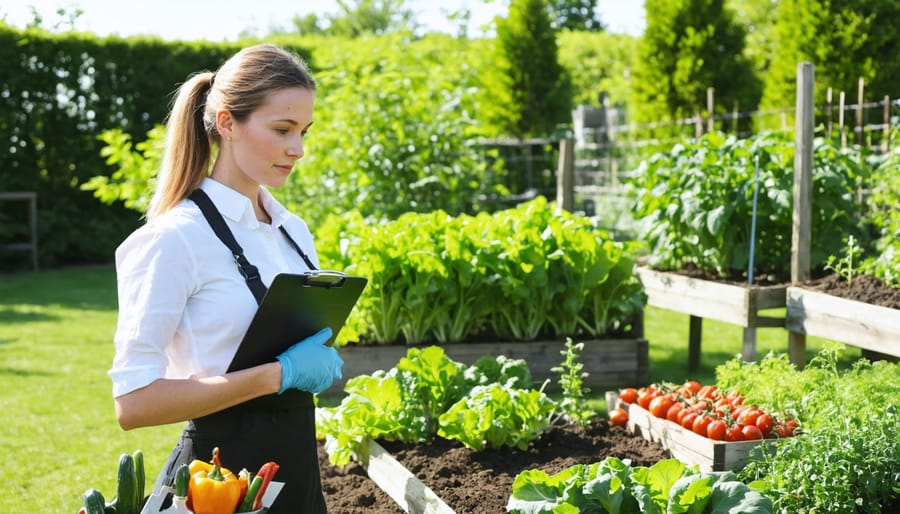Transform ordinary gardening activities into magical learning moments for preschoolers through engaging garden videos that capture their imagination and foster early science skills. Combine vibrant close-ups of sprouting seeds with simple, sing-along instructions that make complex concepts accessible to young minds. Keep episodes under 5 minutes, featuring colorful props and recurring puppet characters who demonstrate basic gardening tasks like watering and planting. Structure each video around a single, clear concept – from watching worms wiggle through soil to observing butterfly visitors – while incorporating age-appropriate counting, colors, and sensory exploration. This dynamic approach to garden education nurtures both curiosity and confidence in our youngest green thumbs, laying the foundation for lifelong environmental stewardship.
Essential Elements of Preschool Gardening Videos
Keep It Simple and Colorful
When creating gardening videos for preschoolers, vibrant colors and simple concepts are your best friends. Use bright, primary colors in your visual elements, and focus on easy-to-recognize plants like sunflowers, cherry tomatoes, and colorful lettuce varieties. Keep demonstrations basic – showing how seeds are planted, water helping plants grow, and the transformation from tiny sprout to full plant.
Break down gardening activities into short, memorable segments of 2-3 minutes each. Young children respond well to repetitive motions and simple counting exercises, like “let’s dig three holes” or “pat the soil two times.” Include close-up shots of interesting textures and colors, such as bumpy seed packets, smooth stones, or rainbow-colored garden tools.
Incorporate familiar characters or props, like garden gnomes or friendly insects, to maintain engagement. Use clear, cheerful language and avoid complex gardening terminology. Instead of “fertilizer,” say “plant food,” and replace “germination” with “waking up the seeds.” Remember to show genuine excitement when plants start growing – preschoolers feed off this enthusiasm and it helps maintain their interest in the gardening process.

Characters and Story Elements
When creating gardening videos for preschoolers, lovable characters can transform educational content into an engaging adventure. Consider introducing a friendly garden gnome who guides children through activities, or animated vegetable characters that explain their growing needs. A recurring mascot, like a wise owl or industrious bee, can become a familiar friend that children look forward to seeing in each episode.
Simple storylines work best when they follow a clear pattern: introducing a garden challenge, exploring possible solutions, and celebrating success. For example, “Helper Henry the Hedgehog” might need assistance planting sunflower seeds, creating an opportunity for viewers to learn the planting process while helping their new friend.
Include gentle conflicts that preschoolers can relate to, such as waiting patiently for seeds to sprout or learning to share garden tools. These scenarios teach both gardening skills and valuable life lessons. Remember to keep stories short and resolution-focused, with plenty of opportunities for viewer participation through questions, movements, and simple songs about gardening activities.
Incorporate seasonal characters who appear at specific times, like “Spring Sally” or “Summer Sam,” to help children understand growing seasons and maintain excitement throughout the year.
Making Gardening Activities Preschool-Friendly
Quick-Result Projects
Maintaining preschoolers’ interest requires quick and effective gardening activities that show results fast. Bean sprouts in wet paper towels can emerge within 3-5 days, making them perfect for short video segments. Place the seeds between damp paper towels in a clear container, and film daily progress to create excitement about growth.
Carrot tops in water dishes offer another engaging project. Simply cut the top inch of a carrot and place it in a shallow water dish. Within days, children can watch green shoots emerge, creating a magical transformation they can follow on screen.
Grass heads are particularly entertaining for young viewers. Using old stockings filled with soil and grass seeds, create funny faces that sprout green “hair” within a week. This project combines creativity with plant growth, perfect for maintaining engagement across multiple video episodes.
For ultra-quick results, try growing microgreens in shallow trays. These tiny plants can sprout within 24-48 hours and are ready to harvest in just a week. Film the entire process from seeding to harvesting, creating a complete story that young viewers can follow from start to finish.
Remember to capture close-up shots of the sprouting process and include children’s reactions in your videos to make the content more relatable and exciting for your preschool audience.

Safe and Simple Tools
When creating gardening videos for preschoolers, it’s essential to showcase tools that are both safe and manageable for little hands. Child-sized trowels, plastic watering cans, and soft-bristled brushes are perfect starters that allow young gardeners to participate without risk. Look for tools with rounded edges and lightweight materials specifically designed for children.
For demonstrations, always feature tools with brightly colored handles, which not only appeal to preschoolers but also make them easier to spot in the garden. Small buckets, plastic plant markers, and child-safe gloves are other excellent options to include in your video content.
Safety should be prominently featured in your demonstrations. Show proper tool handling techniques, such as carrying tools pointing downward and keeping a safe distance from others while working. Consider including a friendly reminder song or rhyme about tool safety that children can easily remember and repeat.
Avoid showing any sharp tools, chemical sprayers, or heavy equipment in your videos. Instead, focus on simple hand tools that promote fine motor skills development. When demonstrating digging or planting, use tools with clear grip markers to show children exactly where to place their hands.
Remember to store tools safely after use – incorporate a clean-up routine into your videos, showing children how to wash their tools with water and place them in designated storage areas. This helps establish good gardening habits from an early age.
Technical Tips for Filming
Camera Angles and Lighting
When creating gardening videos for preschoolers, getting the camera angles and lighting right is crucial for maintaining their attention and making the content accessible. The key is to film from a child’s eye level, typically between 2-3 feet from the ground. This perspective helps young viewers feel more connected to the content and better understand the gardening activities being demonstrated.
Consider using a combination of video filming techniques that capture both the big picture and close-up details. Position your camera at their height when showing garden beds, tools, and planting activities. For demonstrations, use overhead shots sparingly and focus more on side-angle views that children would naturally see.
Natural lighting works best for garden videos, but aim to film during the “golden hours” – early morning or late afternoon – when the light is softer and more flattering. Avoid harsh midday sun that creates strong shadows and can wash out colors. If filming on cloudy days, the diffused light can actually work in your favor by providing even illumination.
Remember to keep the camera steady using a tripod or stabilizer, as shaky footage can be distracting for young viewers. When showing small objects like seeds or insects, zoom in slowly and maintain focus to help children follow along easily. Consider using child-sized tools and hands in the frame to provide relatable size reference points.

Pacing and Duration
When creating gardening videos for preschoolers, timing is everything. The ideal length for a preschool-focused gardening video should be between 3-5 minutes, as young children typically have shorter attention spans and may lose interest in longer content.
Break down each gardening activity into bite-sized segments of 30-45 seconds, allowing young viewers to process and understand each step. Maintain a steady, unhurried pace throughout the video, giving children time to observe and absorb the information. Include brief pauses after demonstrating important actions, such as planting seeds or watering plants.
Consider incorporating simple repetitive elements, like a recurring character or catchphrase, every 60-90 seconds to maintain engagement. These familiar touchpoints help preschoolers stay focused and create memorable learning moments. Use transition elements, such as gentle music or sound effects, to signal shifts between different activities.
Remember to include interactive moments where children are encouraged to participate, such as counting seeds or mimicking planting motions. These engagement points should be spaced throughout the video, roughly every 45 seconds, to keep young viewers actively involved.
For more complex gardening activities, consider breaking them into multiple shorter videos rather than creating one lengthy episode. This approach helps maintain attention and makes the content more digestible for young minds while creating natural stopping points for breaks or discussion.
Creating gardening videos for preschoolers is a rewarding endeavor that combines the magic of nature with early childhood education. By following the guidelines and tips shared in this article, you can develop engaging content that sparks curiosity and nurtures a love for gardening in young minds.
Remember to keep your videos short, colorful, and interactive, incorporating simple activities that little hands can manage. Use clear, age-appropriate language and plenty of visual demonstrations to help children understand basic gardening concepts. Don’t forget to include safety guidelines and make the learning experience fun through songs, characters, or storytelling elements.
Parents and educators, you have a unique opportunity to shape the next generation of garden enthusiasts. Start small, perhaps with a simple seed-planting video, and grow your content alongside your young audience. The joy on a child’s face when they see their first seedling emerge or harvest their first cherry tomato makes every effort worthwhile.
Whether you’re filming on a smartphone or with professional equipment, the most important ingredients are enthusiasm and authenticity. Your passion for gardening will shine through and inspire little ones to develop their own connection with nature.




